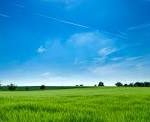- September 15, 2023
- By admin
- Future Farming
- (0) Comment Post Views : 1847

Introduction:
In today’s world, agriculture faces numerous challenges: feeding a growing global population, conserving resources, and minimizing the environmental impact. Fortunately, technology has come to the rescue. Satellite-based farming solutions are transforming the agricultural landscape, providing farmers with tools and data to make informed decisions, increase yields, and reduce waste. In this blog, we will explore the incredible potential of satellite-based farming solutions and how they are revolutionizing the way we produce food.
Satellites: The Eyes in the Sky:
Satellites orbiting our planet are much more than just points of light in the night sky. They serve as powerful tools for collecting data about Earth’s surface. In agriculture, this data is a game-changer. Satellites equipped with sensors and cameras capture information on soil moisture, temperature, crop health, and more. This real-time data allows farmers to monitor and manage their fields with unprecedented precision.
Precision Agriculture:
Satellite-based farming solutions enable precision agriculture, a practice that tailors farming activities to the specific needs of each part of a field. Farmers can use satellite data to identify areas that require more or less irrigation, fertilization, or pest control. This targeted approach not only boosts yields but also reduces resource usage, making agriculture more sustainable.
The Role of Satellites in Agriculture
Satellites orbiting high above the Earth provide a unique vantage point for monitoring our planet’s surface. They offer a wealth of data that can be harnessed to improve farming practices in numerous ways:
Remote Sensing:
Satellites equipped with various sensors can capture detailed images of the Earth’s surface. These images can be used to monitor crop health, identify pest infestations, and assess soil conditions. With satellite imagery, farmers can detect problems early, allowing for timely interventions.
Weather Forecasting:
Accurate weather information is crucial for farming decisions. Satellites provide real-time weather data, helping farmers plan activities such as planting, irrigation, and harvesting with greater precision. This minimizes the risk of weather-related crop losses.
Yield Prediction:
By analyzing historical satellite data along with other factors like soil quality and weather patterns, farmers can make informed predictions about crop yields. This information aids in marketing decisions and resource allocation.
Soil Mapping:
Satellites can create detailed soil maps, which help farmers understand the variability in soil types and nutrient levels across their fields. This knowledge allows for precise application of fertilizers and other soil amendments.
Benefits of Satellite-Based Farming Solutions
Increased Efficiency: Satellite data helps farmers optimize their operations, leading to higher yields and reduced resource consumption. This efficiency translates to cost savings and improved profitability.
Environmental Sustainability:
Precision agriculture made possible by satellites reduces the overuse of fertilizers and pesticides, minimizing environmental pollution and soil degradation.
Risk Mitigation:
Timely access to weather data and crop health information allows farmers to proactively address potential issues, reducing the risk of crop losses due to adverse conditions.
Global Reach:
Satellite technology can benefit farmers worldwide, including those in remote or underdeveloped regions where access to traditional agricultural resources may be limited.
Data-Driven Decision Making:
Satellite-based farming solutions provide farmers with data-driven insights, empowering them to make informed decisions that lead to better outcomes.
Challenges and Future Directions
While satellite-based farming solutions offer immense potential, there are challenges to overcome. These include the cost of satellite imagery, the need for user-friendly interfaces, and addressing the digital divide in agricultural communities.
In the future, advancements in satellite technology, including the deployment of more advanced sensors and increased satellite constellation density, will further enhance the capabilities of satellite-based farming solutions. Additionally, improved data analytics and machine learning algorithms will enable even more precise and personalized recommendations for farmers.
Conclusion:
Satellite-based farming solutions are transforming agriculture into a data-driven, efficient, and sustainable industry. By harnessing the power of satellites to monitor crops, soil, and weather conditions, farmers can make informed decisions that optimize resource use, increase productivity, and reduce environmental impact. As technology continues to evolve, satellite-based farming solutions will play an increasingly vital role in ensuring food security for a growing global population. This innovative approach is not only shaping the future of farming but also contributing to a more sustainable and prosperous world.




